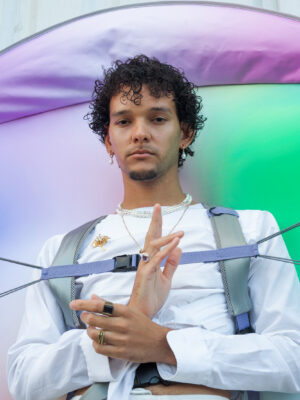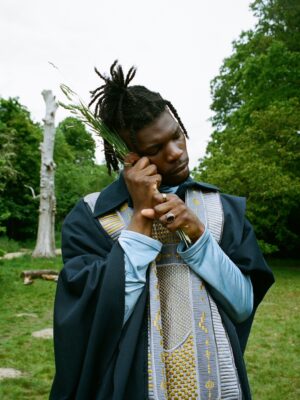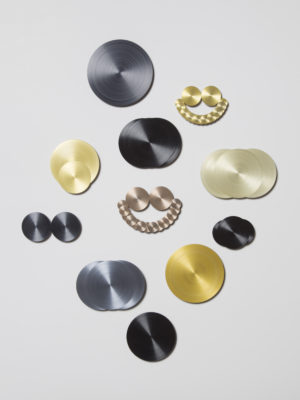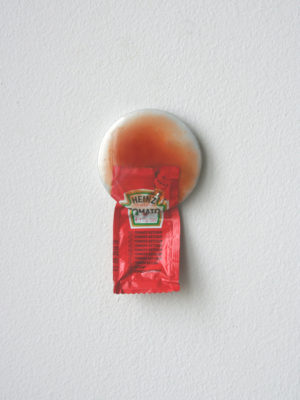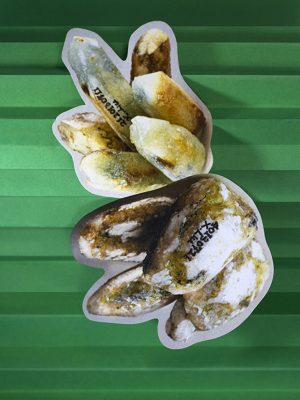What sparks one’s attention when looking at Divino’s work is the strong and resonant voice actively reclaiming their identity, courageously confronting the dilemma of what to leave behind and what to retain in the modern world where the indigenous, the mythical, and the spiritual have been stripped away from everyday life.
In the following months, Current Obsession offered its platform to a selection of writers to explore what modern-day Urban Mythology is and how it transcends through the perspective of jewellery, the use of organic materials, folklore, and womanhood, just to name a few. In the first interview of this series, Margaret Munchheimer speaks with Darwin Winklaar about Afro-Caribbean heritage, understanding one’s identity through altars, and the strong impact of traditions and domestic environment on Darwin’s work.
Margaret Munchheimer: It’s a pleasure to have this conversation with you, Darwin, also known as Niño Divino. Two phrases come up frequently in your work: Neo-Folklorism and Altarismo. Could you elaborate on these for us?
Darwin: So Altarismo is a term I was introduced to by Laura Iperis in her book. The concept delves into the political and spiritual aspects of Chicano and Chicana art. While exploring and seeking ways to better articulate my work, I realised that ‘veneration’ and ‘honouration’ were terms that kept appearing in my research. It occurred to me that I was, in essence, becoming an altar, and my work was evolving into a memory of significant fragments of my life, which I then venerated.
This realisation coincided with my reading of Laura Iperis’ terminologies. I identified with how she framed the works of artists that connected with my own, but from different perspectives, such as photography, fashion, and other mediums. This led me to construct my personal interpretation of Altarismo. While I did base it on Laura’s concept, it was crucial for me to define what it meant to me personally.
In essence, my concept of Altarismo revolves around embracing all aspects of my identity through an altar. When you visit various ritual spaces in Aruba and the Caribbean, you’ll notice that each household has its own altar, unique prayers, candles, saints, and specific imagery. Despite the diverse expressions, I feel connected to all of these rituals and altars because we share common experiences, although our imaginations differ.
I have always venerated aspects of my life such as my childhood, my mother, and the women who have been pivotal in my life. Through this veneration, I see myself as an embodiment of these influences. I am my mother, the Indigenous consciousness, a piece of Afro-Caribbean heritage, a part of my father, and the macho culture. All of these facets form an altar of their own. Whenever I present these altars in my work, I activate them. This is why my artwork often involves performances – I am part of that altar’s activation.
Margaret: So, it’s all about the ritual. The artwork is a ritual and you, by creating the work, are akin to a ritual in motion. It’s about embracing all these different aspects.
Darwin: Precisely. I embody these powerful personas that have influenced my life. By doing so, I encounter new methodologies, which open new ways to further expand the concept of Altarismo.
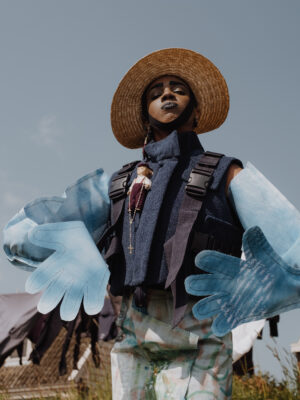
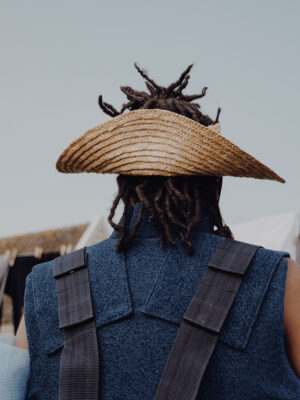
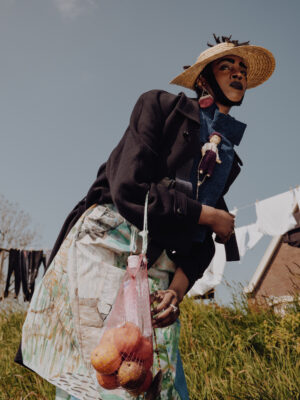
Margaret: I love how your work encompasses so many elements, like the strong correlation your work has with the domestic sphere. I hadn’t realised until now that it’s because an altar is fundamentally a household entity. Therefore, it’s inherently intimate and distinct.
Darwin: Yes. When I speak of the household, I refer to its specific elements, especially the ones that carry complex connotations within the Aruban or Caribbean culture. Machismo is one of them; it plays a massive role in our society, extending its influence within family households as well. Generally, the father is expected to be the primary provider, while the mother tends to household duties.
It’s quite common in the Caribbean for fathers to leave their families, which significantly impacts the mothers who, more often than not, have never had to work before due to their responsibilities towards their children. I experienced this personally. The father figure’s departure often leaves a legacy of trauma that requires healing. Women often seek this healing through their altars.
The domestic aspect is deeply rooted in these experiences, as is the reality of accidents in Aruba. When you visit, you’ll see small roadside crosses commemorating those who have died, many of them men often engaging in risky behavior. When these men pass away, their families, particularly the women, suffer because they lose a source of income and support. This is where the struggle truly manifests.
For me, women bear the brunt of these traumas and the aftermath. The altar becomes their sanctuary, a domestic space for healing.
Margaret: I understand. This is quite prevalent in your work and it’s something you seem to be deeply involved with. It goes beyond mere veneration, incorporating elements of femininity. It feels like you’re reenacting something.
Darwin: Yeah, a large portion of my work is about healing for me. Many of these female entities I reference struggle with their healing journey. While their altars provide a measure of relief, they often need someone to hear them, to talk to them. The topic of mental health still isn’t given the importance it deserves in Aruba or the Caribbean. It’s still largely taboo, which has created a significant societal problem.
My work serves as political activism while maintaining the personal aspect of these issues that require processing and assistance within households. I see myself as a voice for these women, a conduit for their experiences. I take my mother’s suffering, for example, and try to alleviate it through my work. I serve as a continuous portal for their emotions and experiences.
This is why I describe myself as being in a “three by four dance” between nostalgia and melancholy. This middle ground hasn’t been fully visualized yet, and I believe I’m bringing it to light for them. It’s like creating a nomadic home for them in that gray area, adding color and dimension to it. This process leads us to Neo-Folklorism.
Margaret: Right, I do want to delve into Neo-Folklorism, but first, could you explain the “three by four dance” you mentioned earlier?
Darwin: The “three by four dance” is essentially a metaphor based on the rhythm of traditional folkloric dances in Aruba, like the waltz. You dance in a pattern of “one, two, three, one, two, three, one, two.” It’s a poetic way to describe how I navigate these emotional and cultural spaces.
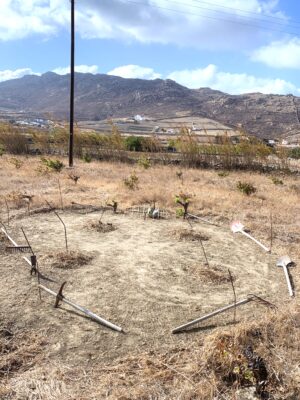
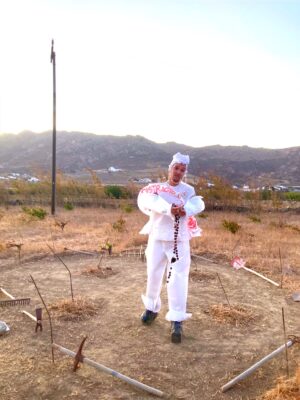
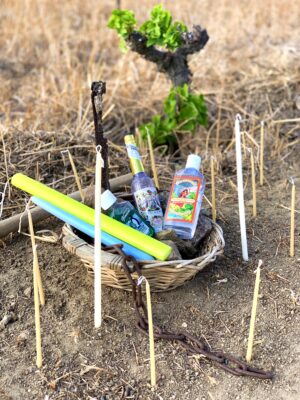
Margaret: Got it! So, Neo-Folklorism. Could you tell us more about that?
Darwin: Of course. Aruban culture tends to be patriarchal and often clings to old mindsets, creating a resistance against experimenting with cultural elements. I’m trying to break through these barriers, challenging taboos, and redefining traditions to create something new.
For decades, there’s been a dearth of artists pushing our culture forward, which is why I label my work as Neo-Folklorism. I am incorporating elements that are typically overlooked in day-to-day life and integrating them so that they become more visible and relatable.
Take music, fashion, or traditional dress, for instance. There’s a tendency to stick with the same patterns, the same cuts of traditional dresses. I questioned this, wondering how I could change the pattern, personalize it, while still drawing on references from the Caribbean and Aruba. By doing this, I am simultaneously deconstructing and reinventing something new from our culture.
Margaret: It’s interesting because my personal experiences come from a small town in the Southern United States. It’s a place where any form of difference is not encouraged, and those who deviate from the norm often face ostracism. The unfortunate trend is that anyone with a hint of divergence leaves the town, reinforcing a cycle of sameness. If you’re considered “weird” in a place like that, the sense of community disappears because all those considered “weird” are driven out. This makes me connect with the idea of how we can transform the culture of a place insistent on staying the same and show them the possibility of change, growth, and acceptance of different versions of themselves.
Darwin: Yeah, exactly. It’s a crucial topic. When I discuss these matters with local people or artists, I remind them that we cannot immediately unmask the colonial mindset we were raised in. It’s a substantial aspect of my work, to help heal the still ongoing impact of colonialism.
I often tell them that referencing European artists isn’t necessary, as we have our own distinctive art that has propelled our culture and the Caribbean art industry. I frequently remind them to use our own people as inspiration.
The current system often compels us to travel to the Netherlands for education. However, upon our return, the qualifications we’ve gained aren’t as highly esteemed in Aruba. There’s a disconnection because we’ve been educated within a European mindset, which doesn’t align with our island culture. I believe we need to rethink this approach.
We should stop sending our students to Europe, when they can study in places like Colombia, Venezuela, or elsewhere in the Caribbean. If I had understood this earlier, I might not have come to the Netherlands. Instead, I would have stayed and embraced my own culture, as I feel I’m doing Aruban work in the Netherlands. While it’s vital, my work primarily speaks to my people, my Caribbean, my Latin American people. I wish for them to appreciate what I do. But the struggle lies in the fact that there’s still no established platform to showcase this kind of work in our homeland.
Margaret: How is your work received in your homeland? Does it have a different response there?
Darwin: Indeed, it’s a different reaction. The younger generation seems fascinated by what we’re doing. They don’t see us fearing anymore. We’re uninterested in hiding; we want to confront and support one another. Initially, this wasn’t the case among local artists, but now, there’s a tangible shift. We’re beginning to sustain and back each other, demonstrating that we don’t have to remain in the aftermath of the trauma left by colonisers. We have our own identity, which is right in front of us, ready to be embraced.
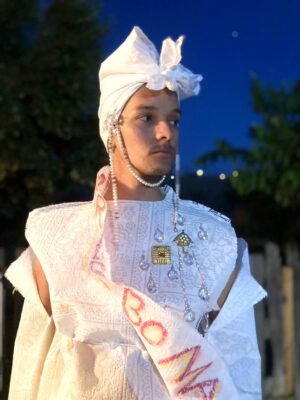
Margaret: Amazing. I noticed, given your background in fashion, that you do much more. Specifically, in your performances, you work with textiles and sewing techniques but not always to create wearable items. You’re utilizing fashion as a lens or foundation, but it’s a completely different type of work. I find the contrast fascinating. Fashion stereotypically is about trends, following what everyone else is doing, conforming to certain patterns – like plaids this year, for example. But your work, like many young fashion artists, deviates from this norm. You’re focused on representing yourself, driven by your own tastes and particularly your own culture. I find this shift compelling. I’m curious to hear your thoughts on the future of fashion as more people engage with this sentiment.
Darwin: Absolutely, I’m so happy you recognised that. It’s funny because, for a long time, fashion didn’t seem like a community to me. It felt exclusive, focused on a single perspective – romanticised thinness, high heels, and other stereotypical representations. Yet, you wonder, what about my friends who are plus-size or have disabilities? Can they also find a place in this industry? So, I asked myself these questions and realised that we must make fashion a safe space for everyone. Everyone should feel welcome in this industry, regardless of their differences. And thankfully, I see more and more people expressing their individuality through fashion. While some still follow trends, I deeply respect those who are doing their own thing, using fashion as a lifestyle and pushing its boundaries.
Fashion should offer safety and empowerment. When you look at various cultures and backgrounds, you can see fashion in all its diversity. Some might label it as craftsmanship, but it’s so much more than that – it’s fashion. It shouldn’t just be about the catwalk, with creations shown once then forgotten. Instead, it should foster conversations. Let’s discuss the story behind a piece – is it a family heirloom, or is it vintage? Typically, you don’t have these discussions when it’s just about one show. But exploring new ways of experiencing fashion, like installations, videos, and performances, opens up new dialogues. It allows us to see fashion differently and create new portals through it.
Margaret: Yes, because despite its historical exclusivity, fashion was always supposed to make you feel good, wasn’t it? Beneath all the commercialization and the layers of social and political issues, it was meant to be empowering. So, I think your point is crucial. There’s been this shift towards recognizing that fashion is supposed to be empowering, so why then, are we excluding and limiting ourselves, enforcing an unnatural or narrowly defined vision of the world?
Darwin: Definitely, definitely. And I believe that’s what we’re witnessing in this era – people finally feeling heard and realizing they’re not alone. I sense that many subcultures and hardworking communities have been suppressed, and now it’s their time to voice their experiences. So let’s give them that voice and platform that they deserve.
Margaret: Yeah. And I know this already, but would you like to share with us about your new project? It’s not just about fashion anymore; you’re branching into a variety of other areas.
Darwin: Yes, you know, it’s so funny because no matter which direction I take, fashion will always be at the root of it. Now, as I transition into a new discipline – music, I’ve realized that fashion hasn’t quite given me the complete cathartic healing I seek. I realized that I have so many elements to incorporate, but then the question arose: how can I do that? It was then that I understood that music could serve as the perfect medium. It allows me to incorporate fashion, performance, conceptual videos, films – pretty much everything, all into a single package. And when people experience this, they encounter all of these multidisciplinary elements in one significant performance or show. It allows them to experience smell, taste, touch, and emotion. That’s why we have such multi-faceted works.
Music has always been a part of my life, but I never thought it was something I could do something with. However, when I was experiencing depression, I began creating demos and singing along with them. On listening to it later, I questioned why I was voicing these negative thoughts. On hearing it from a distance, I could reflect on the state of mind I was in at that time. It was a healing process for me, and I realized that if it was healing for me, why not share it for others to potentially benefit from?
That’s when I decided to make an EP, which then led to a long play for an album, connecting with visuals and everything I’ve been through. This is the altar I’m opening for them. I’m inviting them into this retablo, as they like to say, to experience this realm of sound, color, performances, and fashion pieces. It becomes a whole world for them to immerse in – a complete utopian environment.
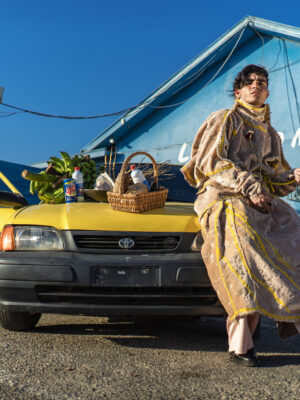
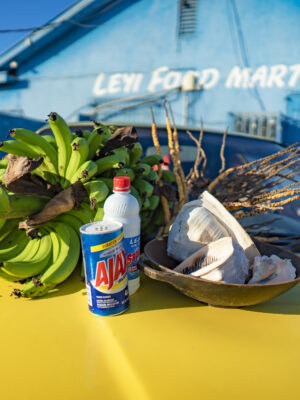
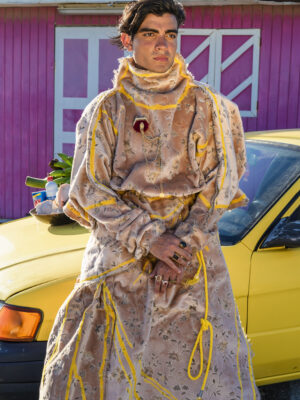
Margaret: So, it started as a sort of self-healing exercise for you, perhaps without even fully realizing it at the time. And then you thought, ‘Okay, maybe I can expand on this.’
You started this during the COVID period, right?
Darwin: Yes, that’s right.
Margaret: And now you have an album coming out.
Darwin: The upcoming EP consists of six tracks. It’s conceptual in nature, with each of the tracks featuring their own unique visuals and short film. Collectively, these will form a larger short film, setting up a narrative for the subsequent album. The EP essentially serves as an introduction to who Neo Divino is and the world that lies behind Neo Divino – explored through the medium of music and visuals.
When it comes to the full album, it delves deeper into the primary themes that I want to emphasize more. These include the states of depression I experienced four years ago, as well as the states of ‘altarismo.’ Everything is slowly unfolding. So yes, that’s the plan.
Margaret: We’ve spoken about this before, but a constant debate seems to arise when you create something that people don’t perceive as wearable – they question, “Is that wearable? Is it really jewellery? Is it really fashion?” It feels like you constantly have to defend and define what you do. What I deeply appreciated in your performance was the clear thread of your work in fashion – it may not always be traditionally wearable, but it’s functional. It’s doing something.
In your case, there’s also this ritual healing process taking place. So I’m curious to know – how do you see the element of fashion, or working with fabric, or creating textile art reappearing in your work? How does that relate to the music?
Darwin: As I’ve previously mentioned, I have synesthesia, which makes me a highly visual individual. Music inspires me immensely, no matter what I’m creating – be it fashion, drawings, or anything else. Music informs me, guiding my choice of colors, and because of my synesthesia, it helps me more in defining what color palette I will use for the music, the collection, or the jewellery I’m creating. It also influences the textures I use.
So, I find myself constantly obsessing over finding the right materials, different types of objects, or anything that echoes the colour palette or feeling I’m seeking. When I collect these items – whether it’s watches or any other objects I come across – they come together to form the entire world I’m trying to construct.
Therefore, for me, fabrics, materials, objects, books, CDs, vinyl records, crayons, and anything I can find are all integral parts of the process. I collect all these objects for a specific project and keep them in a box.
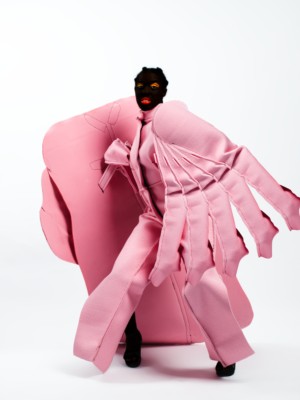
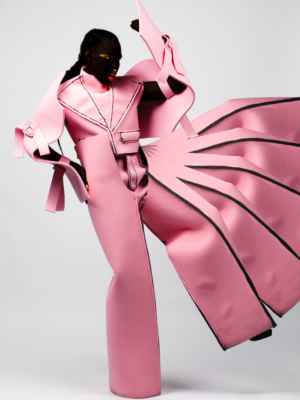
Margaret: So, the music you create also involves colour, right? And what about the performance aspect of it?
Darwin: Absolutely. You know, it’s always a process for me. When I’m composing and I hit the colour that I want, I immediately see the corresponding movements and poses – like forming an altar – that need to come along. These shapes essentially become the project. So, when I’m composing, I’m also considering the choreography, the performance, what I’ll be wearing, and how the set will look like. It’s all packed into one space, like a supercut, all together.
To explain this process is challenging, but everything unravels at the right moment. Of course, I have my sketchbook at hand, jotting down and sketching everything so that I can capture these moments. Then, I can develop them and bring them to life later.
Yes, it’s expected to be released soon if everything goes well. The mixing and mastering process is slated for the end of this month. I’m working with an engineer because, being a perfectionist, I want everything – from the lyrics to the production – to be precisely aligned and clear.
You know, some producers have told me to take my time and not to rush anything because once you release something on a digital platform, it’s there permanently, and you don’t want to regret anything you put out there. I want to have a solid foundation for the project, and that’s what I aim to achieve with my music too.
When I release my work, no one should be able to tell me what I should have changed – I want to be completely sure of my choices. I know that even if you delete something from the digital world because you want to change it, it’s already there somehow. That’s why I want to have my work completely sealed before releasing it.
*Kalokagathia: A classical Greek concept, often translated as the noble ideal of ‘beauty and goodness’. It embodies the ideal of excellence characterised by physical beauty and moral virtue.
Featured images are courtesy of the artist.
This article is part of a larger exploratory series called Urban Mythology commissioned by Current Obsession. The theme blends personal mythology and modernised traditions to present a new take on identity, oral history, and symbolic language. Reclaiming history and decolonising the past and future through innovative narratives and in-depth research, it examines anything from beliefs, (cyber) deities, folklore, shamanism, to the creative prowess of multicultural artists. Diving into a world where ethereality meets living jewellery, where history is not just retold but reimagined. Urban Mythology seeks to explore the richness of our past and present, redefining our traditions and propelling us towards an uncharted future.
